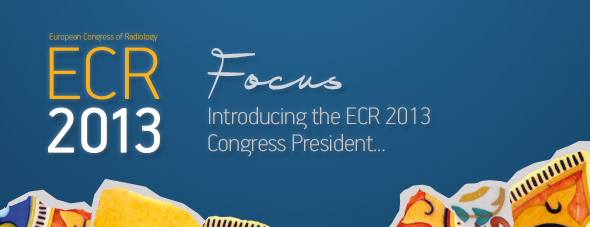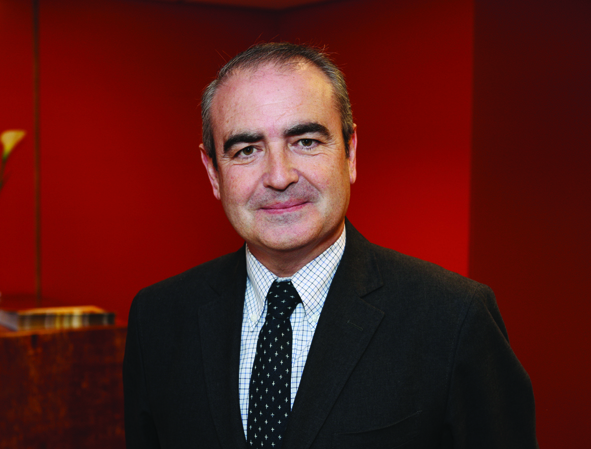Introducing the ECR 2013 Congress President …

In March 2012, we met with ECR 2013 president, Professor José Ignacio Bilbao to interview him for ECR Today, the daily congress newspaper. He talked about the ECR’s scientific programme, how he plans to increase multidisciplinarity and interactivity next year, as well as his passion for architecture.
ESR: What will be the main highlights of ECR 2013’s scientific programme?
José Ignacio Bilbao: We will have a categorical course devoted to the evaluation of tumour response, which is a major issue. We will focus on how to evaluate response after any kind of therapeutic treatment or palliative procedure. It is not an easy course but it has a very well balanced programme.
The Categorical Course ‘Clinical Lessons for Imaging Core Knowledge (CLICK)’ will focus on arteries. I’m an interventional radiologist and I have been working with catheters and arteries all my life. We will keep the course very practical, by addressing different clinical problems in each session. The third categorical course will focus on urogenital imaging, to complete the course started this year. We want to cover the issue completely so all the remaining topics will be dealt with next year.
In addition, we will have a Foundation Course on neuroimaging and a New Horizons Session on how to evaluate response in haematological disorders. There will also be two Mini Courses on ‘The Beauty of Basic Knowledge’, as we realised it was necessary to establish or refresh basic knowledge. One course will be dedicated to musculoskeletal imaging and the other to head and neck radiology. There will be one speaker each day and both courses will be completely interactive.
Furthermore, we will maintain the ‘A to Z’ Mini Course, focusing this time on cardiac imaging. We are thinking of incorporating PACS into the session, to put radiologists in the real-life situation of writing reports or examining a patient, not just with a few unrepresentative images but also using information taken from CT or MR. This should be innovative and interesting from the practical point of view, because participants will see how a specialist deals with patients on a daily basis. An additional Mini Course will be dedicated to controversies in breast imaging which is a challenging topic.
ESR: Recently the ECR has focused on both multidisciplinarity and interactivity. Do you plan to increase time slots for these topics?
JIB: Yes, we will try to encourage all kinds of multidisciplinarity and interactivity. We will have three multidisciplinary sessions on liver tumours, an increasing problem around the world. One session will be dedicated to hepatocellular carcinoma, another to metastases and the last one to cholangiocarcinoma. These sessions will see hepatologists, oncologists, pathologists, radiologists and surgeons discussing issues regarding the management of patients with liver cancer in the hospitals where they work together.
Moderators will have an important, interactive part in the organisation of the sessions. They will not just introduce the speakers; they will also need to interact. All sessions within the categorical courses will conclude with cases. Some will be discussed between the speakers, or the moderator will present some representative pictures from these lectures.
In general, I would like to include the cases used during the sessions in some of the eLearning tools offered by the ESR. Sometimes you encounter some very interesting cases, which you would like to discuss later, but they are no longer available. Having the ability to see them later would further improve interactivity.
ESR: You were chairman of the Electronic Presentation Online System (EPOS™) scientific exhibition last year. What do you think of the format of the exhibition at the ECR?
JIB: I am really looking forward to the live poster discussions we introduced last year. Being able to ask the author about this or that particular issue is really perfect for open discussion. EPOS is the biggest archives system available; it gives us the opportunity to structure our knowledge. It is also a great self-assessment tool. Posters are useful for giving flesh to the skeleton of knowledge.
ESR: Apart from Spain, which will be the next countries and partner disciplines invited to take part in the ‘ESR meets’ programme?
JIB: We will welcome Chile and South Africa. I wanted to have another South American country, as so many people speak Spanish in America, including the United States. The Radiological Society of Chile will focus on local ongoing radiological research. The Radiological Society of South Africa will focus on local issues such as tuberculosis and AIDS, and I am sure we will learn a lot from them. The Spanish Radiological Society will present a session entitled ‘Imaging: essential tool from diagnosis to treatment’.
We have also invited the European-African Hepato-Pancreato-Biliary Association to join us for sessions on pancreatic cystic neoplasms. This society is mainly run by surgeons but they are multidisciplinary, they understand that the treatment of tumours is a multidisciplinary concept. This fits perfectly with our thinking. The sessions will feature surgeons and hepatologists, as well as radiologists.
ESR: The global financial crisis has not spared Europe and the pressure on healthcare budgets has increased. Do you think it will impact on the ECR in the future in terms of sponsorship?
JIB: Sponsors will always endorse quality. If you provide something worthwhile they will endorse it. The ECR is excellent, its programme is second to none and the city is perfect; everywhere around you can feel quality. I imagine that sponsorship will increase.
ESR: A more personal question: how did you decide to become a radiologist?
JIB: When I was in my third year of medical school I discovered that I should have studied architecture. I have always been impressed with dimensions, lines and structures. But I soon marvelled at the many parallels between architecture and radiology.
Then, during my residency, I found that I could navigate through the dimensions, work with my hands and interact with anatomy very quickly and creatively. That was in 1982, when I was working as an interventional radiologist in Houston, U.S. Within a week, I knew this was what I had to do. The work done in interventional radiology can have a great, important and direct impact on the disease of a patient.
ESR: What do you do when you are not working?
JIB: Well, I spend a lot of time working. I enjoy the great outdoors, and Middle-age and Romanesque art. I love to combine those interests by visiting Romanesque churches in the countryside, for instance in Castilla and Navarra, or by walking along St James’ Way (Camino de Santiago de Compostela), which crosses the university campus of Pamplona. I wish I had more time to do this. It is fascinating to visit monuments that have been seen by millions of people over the centuries.
ESR: Are you glad you came back to Vienna this year?
JIB: Absolutely. When you go to the congress, you feel like you’re with your radiological family. It’s very special to be here, I’m very happy. My first ECR was in 1991, and I’ve been coming to all the congresses since then, except in 2007, when I was taking my examination to become professor. Vienna is a very pleasant city and it has become even more beautiful over the past few years.
José Ignacio Bilbao is Professor of Radiology and Head of Interventional Radiology at the Navarra University Hospital in Pamplona, Spain.
This interview previously appeared in ECR Today 2012 and the ECR 2013 Preliminary Programme Edition I


